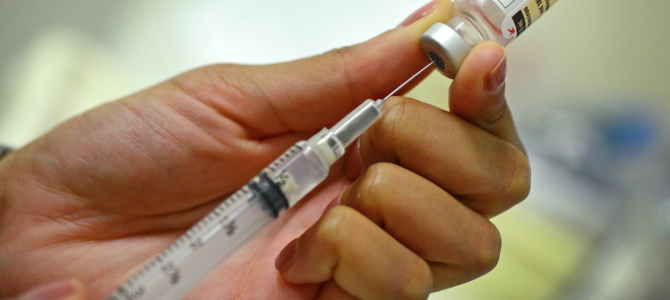
In recent years, religious exemptions from vaccination mandates have been eliminated in some states. It began in 2015 in California, followed by Maine, New York, and Washington. Although protecting ourselves and others with vaccinations seems like the reasonable and Christian thing to do, there remains a significant reason to retain religious or conscience exemptions: Several vaccinations use cell lines derived from aborted fetal tissue.
To produce vaccine antigens, viruses are propagated in host cells of other types. To maintain a ready and manageable supply of host cells, cell lines — a subculture of cells isolated from organic tissues — are maintained in laboratories. Two cell lines, named WI-38 and MRC-5, derived from the tissue of aborted fetuses, serve the manufacturing of some vaccines used in the United States.
The existence of WI-38 and MRC-5 is not new and has been defended extensively by three main arguments. First, the fetuses were not aborted for the purpose of making the vaccines. Second, these existing cell lines do not require ongoing abortions. Third, the overall benefit to public health is a worthy reason to continue manufacturing these vaccines. Let us consider these arguments in turn.
The Purpose of the Abortion
While mothers may not have had vaccines in mind when choosing abortion, abortionists and researchers had established relationships for this purpose. Researcher Leonard Hayflick sought out aborted human fetal tissue because he reasoned it would be less likely than other tissues to be contaminated by viruses. He also showed that fetal cell lines have the advantages of numerous subcultivations and susceptibility to viruses, making them ideal for mass producing vaccines.
Nineteen fetuses were used to develop cell lines WI-1 through WI-25, and after they were lost when Hayflick’s lab freezer failed, he acquired more aborted-baby tissue from a colleague in Sweden. Using this tissue, Hayflick developed more cell lines, with line WI-38 continuing to be used today for vaccine production. Strain MRC-5 was developed from an aborted baby for the purpose of vaccine development.
While parents are not seeking abortions to populate cell lines for vaccine manufacturing, researchers and abortionists recognize the benefit of fetal tissue for vaccine development, and have established relationships to facilitate the supply of this tissue to researchers. Research might be an indirect purpose of abortion, but it is still the intent of some parties involved.
Most lay people today reason, “Of course I’m not participating in the abortions. I wasn’t there. I didn’t encourage the mothers to abort. I wasn’t looking for tissue to develop a vaccine.” If one is not complicit in the abortion, what’s the harm in trying to bring some good out of it?
To make a cell line, the parts of the aborted body are minced, treated with an enzyme solution, and centrifuged into individual living cells to be cultured in a nourishing serum. These cells are subcultured and multiplied. Current cell lines WI-38 and MRC-5 are living cells, derived from the fetus, carrying the same DNA as the body from which they came.
Unlike the abortion itself, which could be distanced from our experience as a singular event in history, the ongoing use of the aborted body continues today, serving the demand for some vaccines.
No More Abortion?
Although advocates of these vaccines argue no more abortions are needed, new cell lines derived from aborted fetal tissue continue to be developed. Researchers are concerned that cell reproduction in these strains will eventually become nonviable, or at least more difficult to access.
They are also motivated to discover increased duplication rates, higher limits to duplication, and improved suitability for viral propagation. Researchers have developed cell lines — including IMR-90, IMR-91, PER.C6, and Walvax-2 — from aborted fetuses, with the intent of supplementing or replacing WI-38 and MRC-5 for vaccine development.
Demand for these vaccines gives implicit abortion approval for fetal tissue research. Promoting products of abortion encourages the partnership between abortion providers and medical researchers, as well as the social acceptance of this partnership. For example, President Bill Clinton justified federal funding for fetal tissue research by the success of these vaccines. While President George W. Bush said, “We do not end some lives for the medical benefit of others,” he allowed “federal funding for research on existing stem cell lines.”
Following the 2015 criticisms against Planned Parenthood for providing fetal tissue for research, researchers responded that such experimentation is necessary, has great benefits, and should continue, pointing specifically to the precedent of vaccine development. While the Trump administration recently ended government funding for most fetal tissue research, the policy change does nothing to alter the legality of fetal tissue research. Recent efforts to develop a vaccine for COVID-19 have again raised the question of the ethics of using fetal cell lines.
Public Health Benefit
What of the ill effects of the diseases these vaccines are given to prevent? Rubella, in particular, can be devastating to the unborn. Would we fail to love our neighbor if we had an effective vaccine yet did not use it?
Even pro-life leaders have expressed their approval of using vaccines produced with fetal cell lines, in cases with no alternative. The Vatican allowed the use of those vaccines for a “proportionate reason:” The overall defense of life expressed by vaccination against rubella was more significant than a boycott of these vaccines, especially if users expressed their objections and recognized the use was under a kind of duress.
Proponents of these vaccines twist the Vatican’s words to sound like approval: The use of such vaccines “was certainly justifiable,” does not “defy the religion’s doctrine,” raises “no theological objection,” and is “morally acceptable.” Yet a careful read of the Vatican’s essay in no way gives this impression.
The Vatican maintained that the preparation, marketing, and use of such vaccines is illicit, and their use can be allowed only because it occurs under coercion. It named the current situation “an unjust alternative choice, which must be eliminated as soon as possible.” Using the vaccines can be justified only if it does more to defend, uphold, and promote life by preventing disease than the refusal to use these vaccines.
The Vatican gave this advice in 2005, with the expectation that Christians’ objections would eventually lead to alternative vaccines. Unfortunately, the guidance did little to disrupt the widespread acceptance of vaccines using fetal cell lines. Rather, in 2009, Merck discontinued the separate measles and mumps vaccines, and offered them only as a combination with the rubella vaccine as MMR or MMRV, both of which use fetal cell lines.
Yet developing and manufacturing vaccines that do not use fetal cell lines is quite possible. Japanese manufacturers have produced both rubella and hepatitis A vaccines using nonhuman cell sources. However, they are not licensed for use in the United States.
Religious Exemptions as Part of a Unified Public Voice
Without clear, firm Christian voices objecting to these vaccines, and without demand for alternatives, it is unlikely any replacements will be developed or made available in the United States. Many Christians are simply unaware of this connection between some vaccines and abortion. We need active and regular publicity of this connection to raise awareness.
The Christian public voice should be clear and consistent. With legislative trends going against religious exemptions, strong statements from religious leaders and institutions become increasingly important. Although federal case law recognizes religious liberty to some extent, official church statements will strengthen individual claims.
Even if official statements don’t say whether we should or shouldn’t get a vaccine, they should uphold the conscience rights to object to vaccine use. Without such institutional support for conscientious decisions, individuals have difficulty arguing for religious exemption.
Christians should also ask providers for alternative vaccines, or, where alternatives do not exist, that they be developed. Such requests can be made of providers, but should especially be communicated formally to vaccine manufacturers and distributors. In some cases, Christians may choose to refuse vaccinations manufactured with cell strains developed from abortions.
In these ways, Christian laity and pastors can embrace a firm stance that the world cannot confuse as acceptance of the status quo. Christians should make clear that the perpetuation of objectionable vaccines and the lack of alternatives is a kind of coercion. A strong Christian voice can restore a situation in which churches have nothing to do with abortion, no longer accepting health benefits at the cost of others’ lives.









